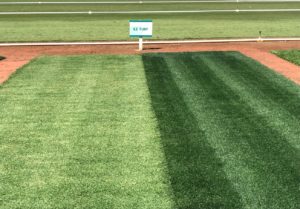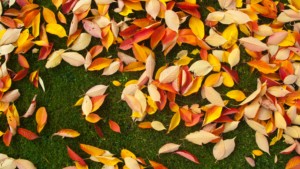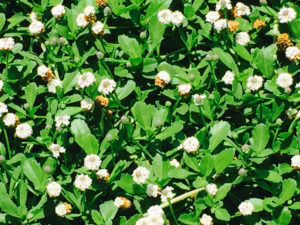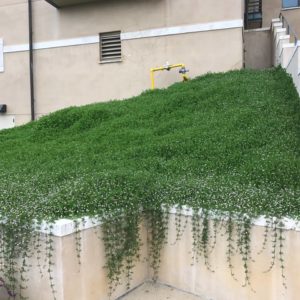Jul
Sod: Not Just for Your Lawn
We often talk about sod on a large scale, from athletic fields and golf courses to housing developments and private homes. But our sod has many more uses, as you’ll see.
Events
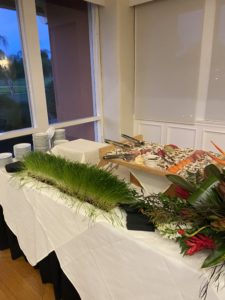 One place sod can be very useful is at events. You can lay down temporary sod for an outdoor area you’d like to soften up and give a more natural look. It looks great as decorative pieces, as well. We recently served a wedding where sod was used as a tabletop, as well as side accents.
One place sod can be very useful is at events. You can lay down temporary sod for an outdoor area you’d like to soften up and give a more natural look. It looks great as decorative pieces, as well. We recently served a wedding where sod was used as a tabletop, as well as side accents.
Compost
One popular and helpful way to use sod is by creating a sod composting pile. When you take out sod to create a hard path or walkway, you will have extra and wonder how to dispose of it. The answer is not to dispose of it at all, put it to use! While the sod is still fresh, find a corner of your yard and lay down a piece of sod grass. Stack face down pieces of sod on top of that, wetting each piece before adding another. Once your composting sod pile is as high as you’d like it to be (not to exceed 6 ft), cover the it in thick black plastic. Weigh the edges down against the ground with stones or cinder blocks, making sure not to let any light to get in. Let your composting sod pile sit until the following spring and uncover it. Inside, you will find rich compost ready for use!
Gardening
Another great use for sod is creating the base for a garden or flower bed. Follow these steps to starting your new garden base! Pile the sod, grass down, in your new garden space until it reaches the desired height. Then cover it with 2–3 inches of topsoil. Finally, add 3–4 inches of mulch. This is a great way to use old sod to increase garden height for better drainage, or even build a tall, raised bed if desired. The sod slowly decomposes into rich soil which will eventually feed the plants in your garden.
Those are just a few small-scale uses of sod. Talk to us about your sod projects – large and small – and see what we can do for you! For more information, visit our website westcoastturf.com
Comments Off on Sod: Not Just for Your LawnMay
New Turf Course Debuts at Churchill Downs – BloodHorse
Churchill Downs kicked off its opening night on April 30 for a season of horse racing. Not just any horse racing – turf racing. This newly revamped track has a $10 million lawn debuted and was a huge improvement from the old turf, which many say was not holding up well. The old mix was four-inch high Kentucky 31 Fescue (90%) and Bluegrass (10%) grown in a three-inch topsoil layer over  a 13-inch course masonry sand base. The new turf course is Tahoma 31 Bermudagrass overseeded with ryegrass. Tahoma 31 is a variety we have at West Coast Turf and is the most water-saving of all the varieties we use. Currently, we have Tahoma at Dodger Stadium, Angel Stadium, and Dignity Health Sports Park (home of the L.A. Galaxy soccer club).
a 13-inch course masonry sand base. The new turf course is Tahoma 31 Bermudagrass overseeded with ryegrass. Tahoma 31 is a variety we have at West Coast Turf and is the most water-saving of all the varieties we use. Currently, we have Tahoma at Dodger Stadium, Angel Stadium, and Dignity Health Sports Park (home of the L.A. Galaxy soccer club).
A little trivia: John Foster had the #2 horse in the Kentucky Derby at Churchill Downs on the dirt surface last year, Hot Rod Charlie, and just got a horse named Tahoma! This Saturday, the country’s most elite racehorses will make their “run for the roses” during the Kentucky Derby.
Why is the Tahoma 31 such a huge improvement on the turf course? Award-winning jockey, Julien Leparoux, says, “For some reason in the spring, the turf course was actually good and by the time we come back in September it was… the opposite of this (new) turf course now. It felt like, even if we didn’t have any rain, it felt we had like 10 inches of rain the day before the races. It was crazy. The horses were going down pretty deep. A lot of kickback. So, I’m glad they fixed it.”
Said jockey Declan Cannon, “With the old course the roots system was dead and there was no growth. And basically, it needed redoing. It had run its course. It just really needed to be replaced.” Churchill jockey Corey Lanerie concurred, “I’m happy to see them invest money in it and redo it because the other one was getting pretty chewed up, and it wasn’t holding together. So, it’ll be safer for the horses and the jockeys.”
In addition to the new mix of grass, they have improved drainage, and the removal of a crown on the outer part of the old course. The crown was there for drainage, but effectively eliminated that part of the course for running. Providing this new turf for the efficiency, and especially safety, of the jockeys and horses is crucial. For more information, visit our website at: https://www.westcoastturf.com/
Comments Off on New Turf Course Debuts at Churchill Downs – BloodHorseApr
Changes in Water Restrictions in California
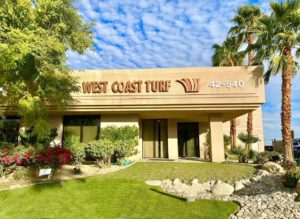 We have all read an article or two lately about the need to cut back on water used outdoors for lawns, trees, and shrubs. We are in a time when water supply is low, and we are caught between trying to keep our homes cooler by having a lawn and using too much water to keep it green. There will always be two sides to this issue as some see lawns and plants as a waste of water and others understand the benefit to the environment. As is the case in politics a blog post or article is not going to change one’s mind one way or the other but being opened to change and learning from each other will help us find a middle ground. Today I am going to talk about ways to reduce water for your turfgrass while keeping the grass healthy, and still providing the benefits to the environment.
We have all read an article or two lately about the need to cut back on water used outdoors for lawns, trees, and shrubs. We are in a time when water supply is low, and we are caught between trying to keep our homes cooler by having a lawn and using too much water to keep it green. There will always be two sides to this issue as some see lawns and plants as a waste of water and others understand the benefit to the environment. As is the case in politics a blog post or article is not going to change one’s mind one way or the other but being opened to change and learning from each other will help us find a middle ground. Today I am going to talk about ways to reduce water for your turfgrass while keeping the grass healthy, and still providing the benefits to the environment.
Grass selection is becoming more and more important. Let us start by examining the difference between warm and cool season grasses. Here in the southwest you can expect to use 30% more water by using a cool season grass when compared to a warm season grass. Cool season grasses grow best between 60-75 degrees whereas warm season grasses grow best between 90-105 degrees. Picking a warm season turfgrass for your area can save a significant amount of water and allow you to curtail water use longer during hot, dry periods. Swapping out a tall fescue lawn for a drought tolerant bermudagrass is much cheaper than you think and it will save water and put money back in your pocket.
The next part of grass selection is determining the right warm season grass for you. Breeders have been working overtime for years to come up with more drought tolerant grasses and they have been very successful. Some of the grasses on the market right now for reducing water are Kurapia (best drought tolerance), Tahoma 31 (second best), Tiftuf (3rd) Santa Ana, Paspalum, and Zoysia (coming soon to WCT). Kurapia is a ground cover that can be maintained on 50-60% replacement of evapotranspiration and even less if you want to slow the growth and put the grass into a state of dormancy during the hot summer. Studies have shown Tahoma 31 to use slightly less water than Tiftuf its closet competitor in the drought market and 20% less water than older bermudagrass varieties. Selecting the right turfgrass will enable your lawn to use less water and maintain drought tolerance through the hot summer.
How much water does grass need to survive? This is a loaded question, and you will get several different answers but on average 1.25” of water per week during the hottest part of the summer will keep your lawn healthy, thriving, and growing. Can you water less than 1.25” and have a good lawn? Absolutely! You could maintain your lawn with a once-a-week deep irrigation cycle during the summer months to keep the plant healthy and alive. The drought tolerant varieties will put your lawn into a state of pseudo dormancy, but the turf will still provide the same environmental benefits. I know for many having a green lawn is important but sometimes its not possible based on available water. In this situation I advise using a product like Endurant Turf Paint to give the lawn the desired color during periods of water reduction. Since the lawn will not be growing much the paint should last 45-60 days.
Raise your mowing height during the summer. The shorter you maintain your lawn, the shallower the root system will be for the plant. Most warm season grasses can be maintained between half and inch and one and a half inches. These are the optimal ranges but do not be afraid to raise the height to two inches and save even more water.
Water infiltration is extremely important. If your soil is a hard pan and water sheets off the ground every time you water, there is some work to do. Grass loves a deep watering which can happen all at once or broken up in the cycle/soak method. This means running 10-15 minutes and then letting it soak for an hour or more before running the second half of the cycle. If you cannot run more than a few minutes of water without runoff its time to aerate and open the soil. This will relieve compaction and allow water to freely get into the soil.
Irrigation systems save time, water, and money. Putting in a smart timer that calculates evapotranspiration and tests soil moisture will help keep water use down and drastically lower your budget. These smart devices calculate real time weather, plant needs, and soil data. You can set them to use 70-80% of ET to keep your lawn growing. Many cities offer free irrigation clocks and soil moisture monitor tools so check with your city and see what is available.
There are so many great options on the market right now to save water and allow you to have a healthy lawn. Remember that a lawn does not have to be bright green to be healthy. No one wants to give up their lawn and no one will have to if we all use some conservation methods. If you have any questions on any varieties send me an email and I will be happy to help you out. For more information about us, visit: westcoastturf.com
Click here for:
-Jay, Mr. Wise Grass
Comments Off on Changes in Water Restrictions in CaliforniaApr
Spring Cleaning Your Outdoor Space
The sun’s out, but it’s not too hot yet – now is the perfect time to get your home, garden, and outdoor spaces ready for spring. Here are some simple steps to getting the spring cleaning done.
- Clean, clean, clean. Wash windows and floorboards, dust off any cobwebs, sweep surfaces, and clear away any debris from fallen leaves and trees. Power wash your patio or deck. Wipe down patio furniture. Clean or replace any outdoor furniture as needed.
- Update your green spaces. Mow your grass, trim your shrubs, redefine garden beds, make sure your natural grass is healthy and in a good routine for watering and mowing. Have fun with it – add pops of color in planters and herbs to your garden for cooking.
- Aerate your lawn, if necessary. If your lawn gets heavy traffic, such as lots of running and playing in the same spot, this can cause soil compaction. A lawn aerator creates openings in lawn turf that allows water and air to penetrate the soil and reach the grassroots. You can rent a lawn aerator at a big box hardware store, or, if you have a small lawn, use a hand aerator to do it. If you must aerate in the spring, consider doing it around Memorial Day, after weeds have started growing but before they go to seed.
- Weed your lawn. If you prefer weed-free lawns, spring lawn care is as much about weed prevention as it is about fostering healthy lawn growth. Depending upon whether a weed is annual or perennial, you will use either a pre-emergent herbicide or a post-emergent herbicide.
- Service your lawn mower. Spring means it’s time to get out the lawn mower and make sure it’s in working order. Start it up – stubborn start-ups are a sign that it might be due for a tune-up (mowers should be given tune-ups once a year). If your lawnmower needs more than a tune-up, then consider getting a new one. Among the key tune-up tasks is sharpening the mower blade. A regular sharpening will ensure the blade severs, rather than tears, the grass, leading to a nice green lawn rather than one with ragged brown tips.
Once your outdoor space is ready, get outside and enjoy this beautiful spring weather! For more information visit https://www.westcoastturf.com
Comments Off on Spring Cleaning Your Outdoor SpaceMar
When Should I Start to Spring Transition My Lawn to Bermudagrass?
I’d like to go over some common questions I have received through the blog in the last few weeks and see if it can help others with some of the same concerns. I always encourage everyone to send over your lawn questions and I will get back to you as soon as I can.
When should I start to transition my lawn back to bermudagrass?
I always recommend starting the process slowly in March and ramping up in April so your lawn has transitioned by May. I know that was a mouth full, but the truth is it’s not a short process unless you chemically transition your lawn. In March its ideal to start to gradually lower your mowing height and remove some of the turf canopy. This is not a scalp, this is lowering the height so the bermudagrass can breathe and get some sunlight. By mid-March you should be mowing two times per week and starting to see some thinning in the ryegrass. By thinning I mean bermudagrass leaves are starting to show between the ryegrass blades. Currently there is no need to fertilize the ryegrass, its time to back off on nutrition until bermudagrass season. In early April you can lightly verticut or even lightly power rake the lawn to remove some of the ryegrass giving way to bermudagrass. The more sunlight you can get in the grass, the faster you will transition. If the ryegrass remains extremely thick and lush you can expect it to provide excessive spring shade slowing down the bermudagrass. When soil temperatures reach 64 degrees (around April 15th) go ahead and apply ammonium sulfate 21-0-0 at 5 pounds per 1000 SF to jump start your bermudagrass. Continue mowing two times per week and gradually lowering your heights until you see the bermudagrass take over.
Spring Transition, keep lowering the height…..
Can I still put down pre-emergent for broadleaves?
Most of the grassy weeds and broadleaves are now germinating so putting down the preemergent will not yield the results you’re looking for. At this juncture its best to spot spray weeds depending on the type. Make sure the product is labeled for the weed you’re trying to control and can safely be used on bermudagrass. Grassy weeds use different chemicals than broadleaves and not all chemicals are safe and effective so check with specialty stores for better products.
What can I do to repair the urine damage from my dogs? Read the rest of this entry »
Comments Off on When Should I Start to Spring Transition My Lawn to Bermudagrass?Jan
Winter Lawn Care for your California and Arizona Sod
The weather stays relatively pleasant and sunny in desert landscapes in Southern California and Arizona, even in the winter. But once the suns dips down, temperatures drop down drastically. What can you do to keep your natural lawn looking beautiful in the colder months? Here are some tips.
Keep mowing!
Mowing your grass can sometimes fall by the wayside during the winter months. It’s recommended that you follow a semi-regular schedule and continue to mow the grass until you see the growth slow. A good rule of thumb is to keep your grass around 2 to 2.5 inches tall throughout the autumn months, since the grass could start to mat above 3 inches. It’s important to keep it the right length, since overgrowth can cause mold or diseases, and cutting it too short hinders the grass’s ability to to store food for growth.
Sustain Growth by Watering
Even though the temperatures are cooler and there is more precipitation this time of year, it’s still important to continue to water your natural grass. Following a consistent watering schedule encourages growth. Do make sure to adjust your automatic sprinklers so they don’t over-irrigate and cause fungal growth.
Don’t forget to weed in the winter!
Weeding may seem like more of a warm weather chore, but it’s just as important to keep up with it in the winter.
West Coast Turf is the expert on all things grass. Let us know what questions you have about keeping your natural turf looking amazing! Visit our website at www.westcoastturf.com.
Comments Off on Winter Lawn Care for your California and Arizona SodNov
Mosquitoes and your California and Arizona Outdoors.
When you think of the deadliest animal in the world, what pops into your mind? Crocodiles, hippos, one of the big cats…great guesses, but all of them are wrong. It’s actually…the mosquito. This fingernail-sized pest can carry Zika virus, Yellow fever, West Nile virus, and worst of all, Malaria. Much of the reported incidents of that is in very hot, humid regions on other continents. But we do get mosquitoes in the hot, dry desert climates of Arizona and California. So how can you enjoy your beautiful natural sod lawn without getting bitten? Here are a few ways.
- Citronella candles
These citrus/floral smelling candles are not only great for decoration, they can help keep mosquitoes away. These are most effective in an environment where the air is still – a covered patio is the perfect location. Always remember to extinguish them!
- Get rid of any standing water
Mosquitoes love standing water. In fact, it’s where they reproduce. Make sure to empty out anything that catches water – wheelbarrows, outdoor water toys, as well as gutters and drain lines.
- Keep your yard under control
This is an important one! Especially in warmer areas, mosquitoes prefer cooler areas in the shade. Use a lawnmower or a string trimmer to cut back brush, tree limbs, and high grass. Making sure any tall grass is trimmed and not creating shadows will make your grass lawn much less appealing to mosquitoes. This is not only good for keeping unwanted pests away, but is also good for your natural sod lawn in general.
West Coast Turf is the leader for California and Arizona products. Please contact us to learn more about what we can do for you and your property.
Visit us online at: https://www.westcoastturf.com
Comments Off on Mosquitoes and your California and Arizona Outdoors.Nov
You’ve Overseeded Your Warm Season Lawn. Now What?
By now, most of you who are going to overseed your California or Arizona sod have either begun the process or have had your seed down for a few weeks. Today, I want to discuss what to do now that you have the ryegrass growing and cooler temperatures are on the horizon.
Getting your ryegrass up and growing is obviously the first step to a successful winter lawn, but what about maintenance? How can you make sure your ryegrass is strong going into the winter and you will have a full stand of ryegrass once the temperatures begin to drop into the 40’s at night? There are several key items associated with a strong winter lawn but early preparation should be high on your list.
I know you put down a starter fertilizer with your seed but let’s remember that fertilizer will move freely in a saturated soil. The new plant took up most of the nutrients from the starter fertilizer application but the residual affect is limited because you’ve been keeping the seed wet for the past few weeks. So what exactly does this mean? Basically, what I’m trying to say is that once you’ve had your ryegrass lawn in for 2-3 weeks I would advise getting a second fertilizer application on the grass.
Comments Off on You’ve Overseeded Your Warm Season Lawn. Now What?Sep
Questions About Fall Overseeding? Check Out This Video Guide From Mr. Wise Grass!
Yes. It is about that time! If you have warm season grass, you are most likely considering overseeding your lawn. Check out this educational video including Q & A from Jay Danek–Mr. Wise Grass himself. After this video you will know exactly what you need to have the best winter lawn in the neighborhood!
Comments Off on Questions About Fall Overseeding? Check Out This Video Guide From Mr. Wise Grass!Aug
KURAPIA GROUNDCOVER SOD BACK IN STOCK!
Great news! We now have our Kurapia drought tolerant groundcover sod back in stock in California and Arizona!
What they’re saying about Kurapia…….
- “After extensive research and investigation, Kurapia was chosen for the following reasons: aesthetics, growth habit, drought tolerance, erosion control, weed suppression, disease resistance, maintenance aspects, and foremost and most importantly–water conservation–with the reduction of water usage. Kurapia met all of these expectations and more. I believe Kurapia will revolutionize the landscape industry
Mark Runk
G&R Engineering
El Cajon, CA
Comments Off on KURAPIA GROUNDCOVER SOD BACK IN STOCK!

